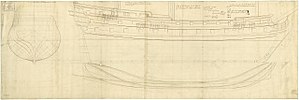HMS Rippon (1712)
 Rippon 1735 rebuild
| |
| History | |
|---|---|
| Name | HMS Rippon |
| Builder | Allin, Deptford Dockyard |
| Launched | 23 August 1712 |
| Fate | Broken up, 1751 |
| General characteristics as built[1] | |
| Class and type | 1706 Establishment 60-gun fourth rate ship of the line |
| Tons burthen | 924 tons BM |
| Length | 144 ft (43.9 m) (gundeck) |
| Beam | 38 ft (11.6 m) |
| Depth of hold | 15 ft 8 in (4.8 m) |
| Propulsion | Sails |
| Sail plan | Full rigged ship |
| Armament |
|
| General characteristics after 1735 rebuild[2] | |
| Class and type | 60-gun fourth rate ship of the line |
| Tons burthen | 1,021 bm |
| Length | 145 ft (44.2 m) (gundeck) |
| Beam | 40 ft (12.2 m) |
| Depth of hold | 16 ft 5 in (5.0 m) |
| Propulsion | Sails |
| Sail plan | Full rigged ship |
| Armament | 60 guns of various weights of shot |
HMS Rippon was a 60-gun fourth rate ship of the line of the Royal Navy, built by Sir Joseph Allin at Deptford Dockyard and launched on 23 August 1712.[1]
Orders were issued on 23 June 1730 directing that Rippon be taken to pieces and rebuilt at Woolwich. Unlike almost every other ship of the line rebuild of the time, Rippon was not reconstructed to the dimensions laid out in the naval establishments, though the differences were not pronounced. As an experiment into increasing the sizes of the Royal Navy's ships in response to the growth of foreign vessels Rippon had one foot added to the gundeck and keel lengths, and the breadth. In addition Centurion, a new-built ship, had previously been built with one foot great breadth over the standard dimensions of the 1719 Establishment.[3] She was relaunched on 29 March 1735.[2]
Rippon served until 1751, when she was broken up.[2]
Notes
References
- Lavery, Brian (2003) The Ship of the Line - Volume 1: The development of the battlefleet 1650-1850. Conway Maritime Press. ISBN 0-85177-252-8.
External links
 Media related to HMS Rippon (ship, 1712) at Wikimedia Commons
Media related to HMS Rippon (ship, 1712) at Wikimedia Commons
